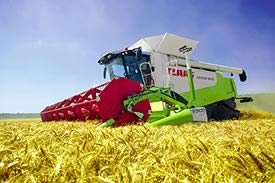10/06/06
With so many tall, thick oilseed rape crops this season and lodging
already evident in some, Claas combine manager, Paul Moss urges
growers to gear up with the right harvesting approach if they are
to avoid a frustrating and time-consuming harvest.
 “Excellent
autumn establishment and rapid late spring growth has left many
taller, bulkier varieties particularly thick this season, with
a relatively high proportion of thinner, weaker stems,” he
explains. “Excellent
autumn establishment and rapid late spring growth has left many
taller, bulkier varieties particularly thick this season, with
a relatively high proportion of thinner, weaker stems,” he
explains.
“They started to suffer in the May rains and are going into the summer
in an acutely vulnerable state. It really won’t take much to knock them
down. So everyone needs to be prepared for the challenging combining conditions
we saw in 2004 rather than last year’s generally trouble-free harvest.”
Under these circumstances, Paul Moss sees desiccation as infinitely preferable
to swathing, pointing out that laid crops don’t allow sufficient stubble
to be left to set up a decent drying swath. And in higher biomass varieties this
will be compounded by the sheer bulk of material, leading to the thick, damp,
matted areas of crop that are the bane of any combine driver’s life.
“Desiccation with Roundup will help dry the crop evenly without pod shattering,
but it will also be vital to set-up and operate your combine correctly,” he
stresses.
“While you’ll have to set the cutterbar low for the
laid areas, for instance, you must
be aware that without a decent rape extension or variable cutterbar
parts of the crop that remain standing can easily go straight over
the header. Which means you’ll have to stop, reverse and
go through it again.
“Setting the cutterbar low, of course, means an increased contamination
risk from soil and other debris if you don’t have an automatic contour
following system. So a lot of extra driver care and attention will be essential.
“Cutting lower also means thicker stalks and far greater potential for
jams,” he adds.
“To compensate you’ll need to lift the table auger to cope with
the bulk, and open your concave settings wider than normal.”
Typically, Claas recommends a 18mm concave setting for rape to
avoid crushing stems and gumming-up the combine. But for this year’s
bulkier crops Paul Moss suggests it may need to be nearer 30mm. He
warns that the concave shouldn’t be opened up beyond 35 mm,
though, or their unique breakaway system won’t have sufficient
leeway to protect the drum against blockage from particularly bad
wads of crops.
Since concentrating up to 9m of thick crop into the 1.7m elevator
throat of a Claas combine – let alone the 1.2 m of many other
machines – will be a particularly tight squeeze, he
urges drivers to be alert for jams; especially where there is no
automatic concave protection or advanced pre-separation ahead of
the main drum.
“Even with good desiccation and the most advanced combine technologies,
you’d be as well to plan on your oilseed rape harvest taking
considerably longer than it did last year if you’ve got tall
and thick crops,” Paul Moss advises.
“Plan to do as much as you can ahead of time to reduce the problems and
you should be able to minimise any knock-on effects on your wheat harvest and
subsequent cultivations.”
 New Claas Lexion 600 takes combining to new output levels New Claas Lexion 600 takes combining to new output levels
 Three new additions to the CLAAS 2006 combine line-up Three new additions to the CLAAS 2006 combine line-up
|


 “Excellent
autumn establishment and rapid late spring growth has left many
taller, bulkier varieties particularly thick this season, with
a relatively high proportion of thinner, weaker stems,” he
explains.
“Excellent
autumn establishment and rapid late spring growth has left many
taller, bulkier varieties particularly thick this season, with
a relatively high proportion of thinner, weaker stems,” he
explains. 